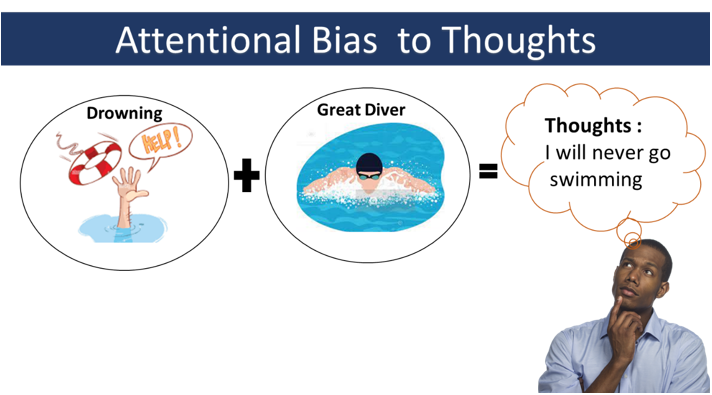Have any questions?
+44 1234 567 890
What is attention bias, and how can it affect mental health?
Written by: Bilikis Banire

Photo from Pexels
Attention Bias
Have you ever been captivated by a striking image or deeply absorbed in a specific thought, seemingly oblivious to the world around you? In case, yes, this is a very common phenomenon and is called an attention bias. An attention bias is like your mind's compass guiding you toward certain things while gently nudging you away from others1. In a world saturated with information that tends to grab our attention or trigger a response from our senses, attention bias becomes crucial. Attention bias is the silent navigator shaping our perception of the world, often operating beneath the surface of conscious awareness. Attention bias can be good but sometimes our response to information around us, such as negative words, scenes, or emotional expressions, could have an impact on our mental health. Figure 1 provides a practical depiction of attention bias, wherein an individual focuses solely on the accidents in swimming or diving, overlooking the significant achievements, and draws negative conclusions based on their perceptions.

Figure 1. Depiction of Attention Bias to Thoughts (Images generated by PROSIT Lab using Google Images)
Attention Bias and Mental Health
Having defined attention bias concerning events and thoughts, it is essential to describe how attention bias operates in mental health. The internal spotlight of individuals with mental health problems is potentially fixated on perceived threats or negative self-perceptions2. One of the methods of minimizing attention bias is the use of attention bias modification training (ABMT) 3. Your mind sometimes tends to focus on negative stuff, like a magnet for things that might stress you out. ABMT is the coach that helps your mind shift its focus away from these negative thoughts. It is like playing a game where you practice looking at positive things and turning your attention away from the negative stuff. In summary, ABMT is your brain's trainer, teaching it to look at the bright side more often and giving those negative thoughts a little less attention. It's all about building mental muscles to stay positive and strong!
Eye-Tracking and Attention Bias Assessment
The popularity of eye-tracking technology is changing the way we assess attention bias. It watches where the eyes go – how many times, for how long – when faced with things that might make someone uneasy compared to neutral items. This way of looking at things gives us a better understanding of attention biases4. It's like having a super-detailed map of where our eyes go, which is especially helpful in studying social anxiety and trait anxiety. This eye-tracking magic not only makes attention bias assessments more accurate but also opens doors to dig deeper into how our minds work during anxiety, offering the promise of more specific help in mental health solutions. Even though ABMT looks promising, there's a bit of an issue when using generic stuff that is not personal to each person. This could make the training less accurate and irrelevant5. Let’s imagine somebody shows you a lot of pictures of snakes and hopes to teach via ABMT to not look at snakes because they are fearful stimuli; but let’s say you really like snakes then teaching you to not look at them might not be great. Now, this is where PROSIT LAB comes in, wwe will do experiments to understand the tricky link between attention bias and mental health, especially anxiety, using a personalized design approach. In other words, we will use stimuli that you think are relevant to you.
Future Direction on Attention Bias Assessment
In conclusion, this journey into the realm of personalized ABMT with eye tracking is not merely an academic pursuit — it is an exploration with tangible implications for the lives of individuals dealing with mental health problems. By focusing on attention bias using eye-tracking and its intervention “ABMT”, we seek to empower individuals with mental health problems with insights that can foster empathy, understanding, and, most importantly, avenues for more effective interventions.
Summary:
- Negative attention bias involves focusing on negative information instead of neutral or positive information. It could sometimes be a negative interpretation of events rather than a positive interpretation.
- Negative attention biases are often linked with mental health problems. Indicating that our negative interpretation of events or information can be because of our deteriorating mental health.
- Attention bias modification can serve as an intervention in lowering our attention bias and mental health problems.
- The eye-tracking device provides a comprehensive and accurate assessment of our attention bias, thereby leading to receiving the required intervention.
References.
- Meier, B. P., & Robinson, M. D. (2006). Does “feeling down” mean seeing down? Depressive symptoms and vertical selective attention. Journal of Research in Personality, 40(4), 451-461.
- Fox, E., Russo, R., & Dutton, K. (2002). Attentional bias for threat: Evidence for delayed disengagement from emotional faces. Cognition & emotion, 16(3), 355-379.
- Bar-Haim, Y., Lamy, D., Pergamin, L., Bakermans-Kranenburg, M. J., & Van Ijzendoorn, M. H. (2007). Threat-related attentional bias in anxious and nonanxious individuals: a meta-analytic study. Psychological bulletin, 133(1), 1.
- Haim, Y. B., & Tel Aviv University. (2021). Increasing Psychological Health and Performance in Soldiers Applying Advanced Eye-Tracking-Based Attention Bias Modification.
- Dennis-Tiwary, T. A., Roy, A. K., Denefrio, S., & Myruski, S. (2019). Heterogeneity of the anxiety-related attention bias: A review and working model for future research. Clinical psychological science, 7(5), 879-899.
Comments